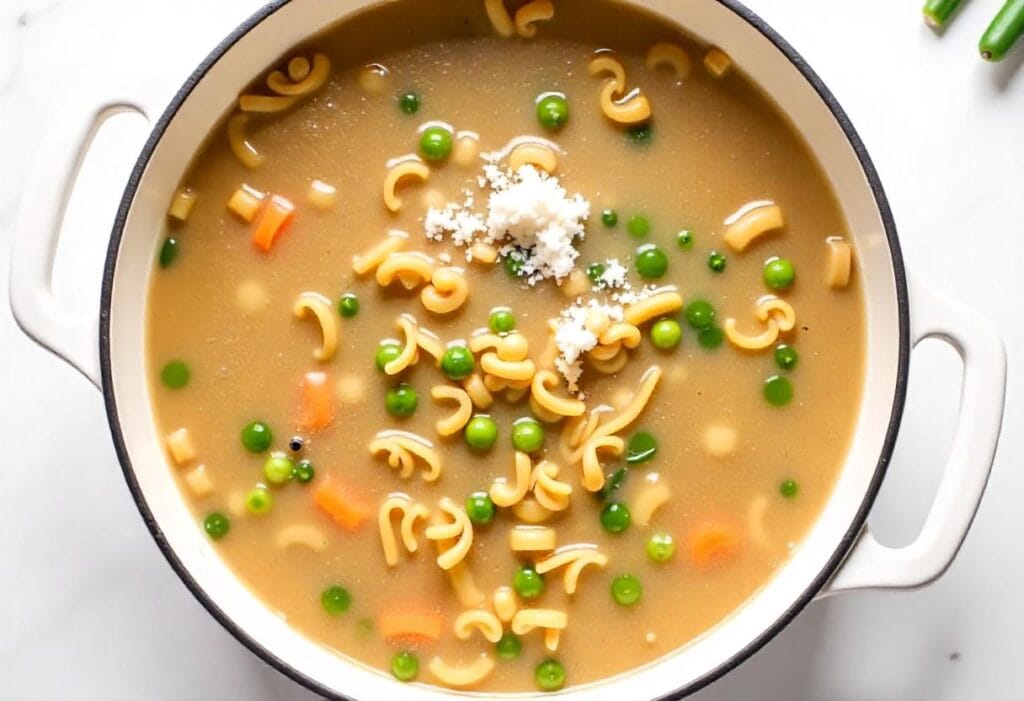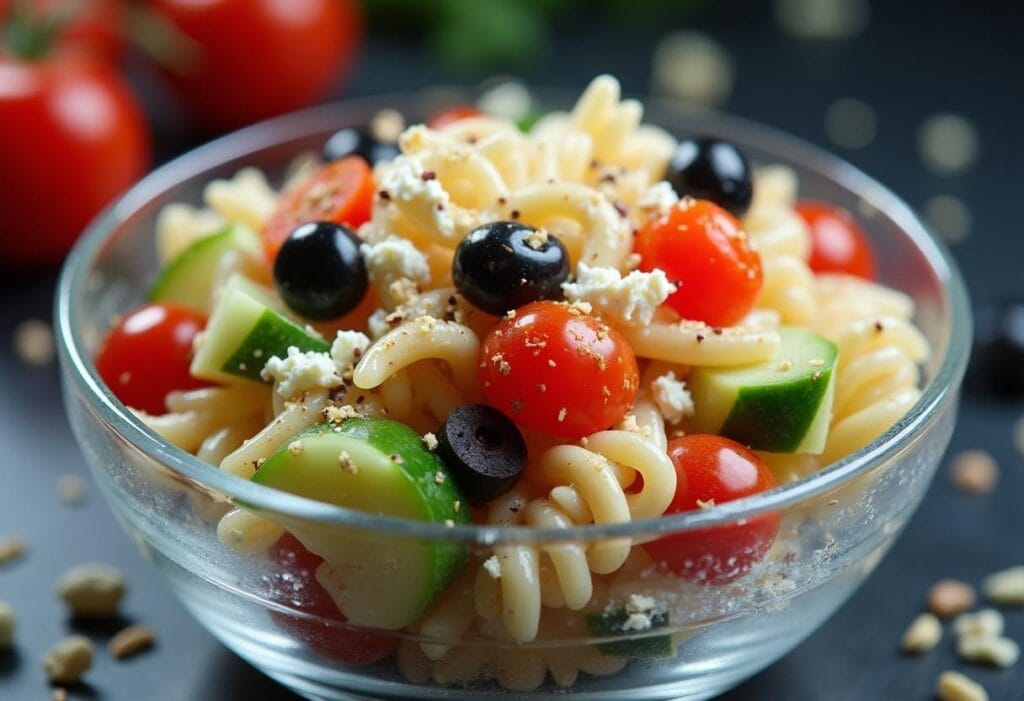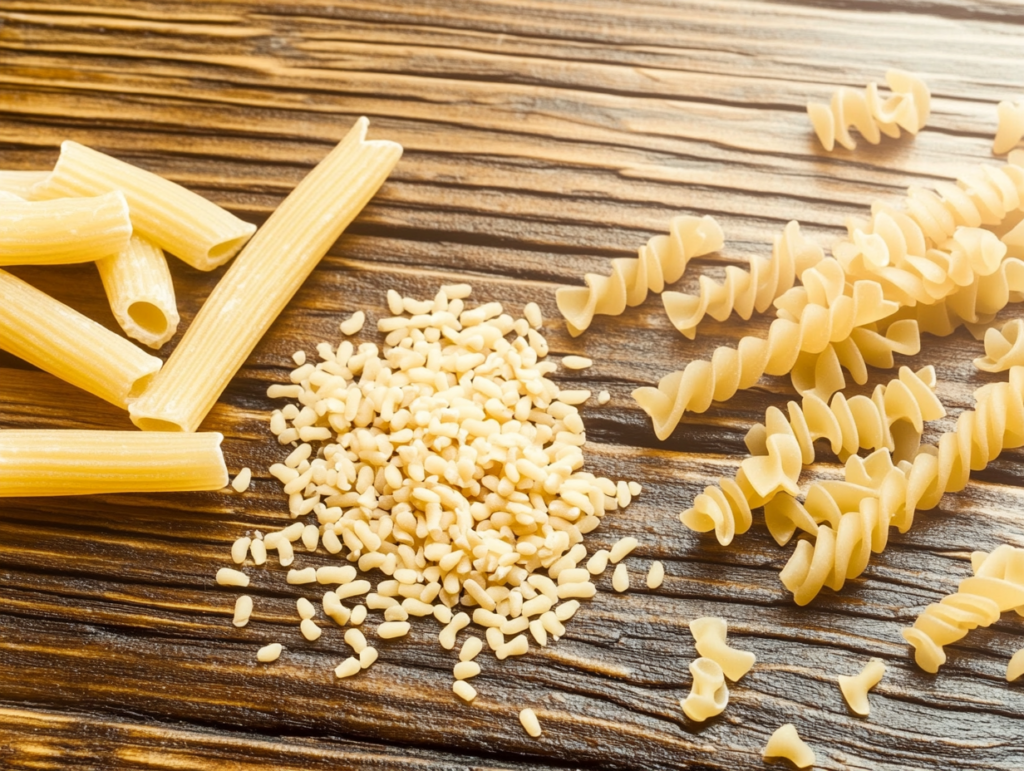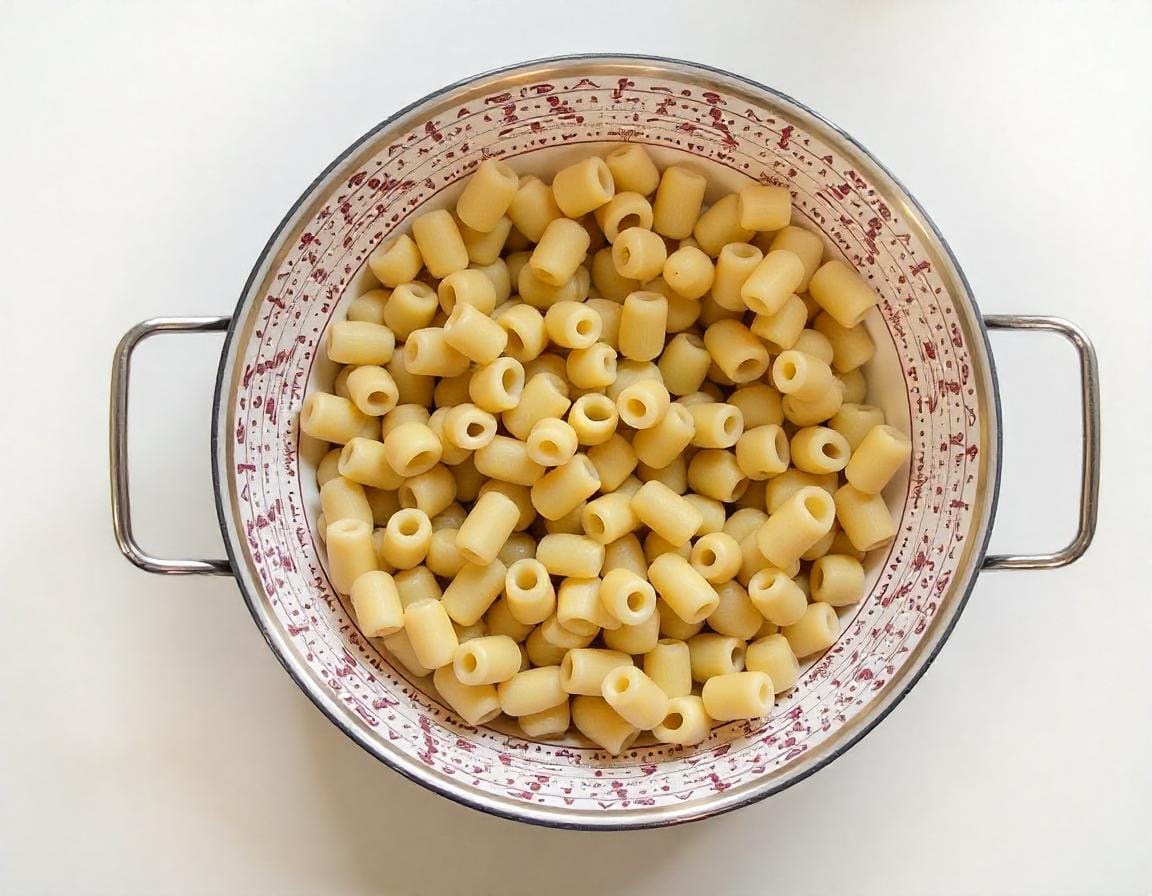If you’re a pasta lover (and who isn’t?), you’ve likely come across ditalini pasta in hearty soups or colorful salads. But have you ever wondered: what is ditalini pasta similar to, and can it be swapped for other pasta shapes? Understanding what is ditalini pasta similar to can help you make smart substitutions in your favorite recipes Let’s dive into the delightful world of ditalini and uncover its secrets, substitutes, and how you can use it to jazz up your meals!
Understanding Ditalini Pasta
Origins and History of Ditalini Pasta
Understanding ditalini pasta’s history helps us appreciate its role in Italian cuisine. If you want to dive deeper into Italian pasta terminology, explore what ditalini means in Italian for an insightful breakdown
Ditalini pasta, also affectionately known as « little thimbles, » hails from Southern Italy, where tradition meets simplicity. Its small, tubular design makes it perfect for dishes like minestrone or pasta e fagioli. While learning about ditalini’s history, many cooks wonder what is ditalini pasta similar to in traditional Italian cuisine. In Italian culture, ditalini has long been cherished as a versatile ingredient that can turn humble soups into comforting masterpieces
« Ditalini pasta has been a staple in Italian kitchens for centuries, beloved for its ability to absorb flavors while still holding its shape. »
Its heritage reflects the Italian knack for creating something extraordinary out of simple ingredients. Isn’t that inspiring?
Key Features of Ditalini Pasta
What sets ditalini apart? Its size and shape! These tiny tubes are bite-sized, making them ideal for spoon-friendly meals. Unlike spaghetti or penne, ditalini doesn’t overpower a dish—it harmonizes with it. Their hollow centers? Perfect for catching bits of sauce, broth, or cheese. Yum!
What Makes Ditalini Pasta Unique?
Shape and Texture
Ditalini is like the chameleon of the pasta world. It’s small enough to blend into soups but sturdy enough to hold its own in salads. The texture? Smooth and satisfying, offering a gentle chew that complements a variety of ingredients.
Cooking Time and Versatility
Because of its petite size, ditalini cooks quickly—usually in about 8-10 minutes. That’s a lifesaver when you’re in a hurry to whip up a comforting dish! Plus, it adapts beautifully to almost any recipe, from brothy soups to creamy casseroles.
What Is Ditalini Pasta Similar To?
Ditalini pasta might feel one-of-a-kind, but it does share similarities with other small pasta shapes. If you’re looking for a full guide on alternative pasta shapes, check out What Pasta Shapes Are Similar to Ditalini?
Let’s explore these alternatives and see why they’re worth considering when you’re out of ditalini.
What Is Ditalini Pasta Similar To: Small Pasta Shapes Compared
Think of ditalini as the cousin of:
- Elbow Macaroni: These iconic « half-tubes » are slightly larger but share a similar hollow design.
- Orzo: While technically shaped like rice, orzo mimics ditalini’s adaptability in soups and salads.
- Tubettini: A close twin to ditalini, but slightly smaller. Perfect when you want a finer texture.
- Acini di Pepe: Tiny, round pearls of pasta that mimic the spoon-friendly ease of ditalini.
Why These Shapes Work as Substitutes
The magic of ditalini lies in its ability to soak up surrounding flavors. When considering what is ditalini pasta similar to, it’s important to note that each of these substitutes shares that characteristic in its own way. Orzo melts seamlessly into creamy dishes, while tubettini offers a more delicate bite in broths. Elbow macaroni? A classic for casseroles when you need something heartier.
Ideal Recipes for Ditalini Alternatives
Wondering when to use these substitutes? Here’s a quick table to help:
| Dish Type | Best Substitute | Why It Works |
|---|---|---|
| Minestrone Soup | Tubettini | Similar size, blends well with broth. |
| Creamy Pasta Salad | Elbow Macaroni | Holds creamy dressings without becoming mushy. |
| Stuffed Bell Peppers | Orzo | Adds texture without overpowering other fillings. |
| Chicken Broth Soup | Acini di Pepe | Tiny size pairs well with delicate flavors. |
Cooking Tips for Ditalini and Its Alternatives
Cooking pasta may seem straightforward, but when it comes to tiny shapes like ditalini, a little attention goes a long way. Understanding what is ditalini pasta similar to is essential for adjusting cooking times appropriately
Matching Pasta to the Recipe
Here’s the golden rule: Choose pasta that complements your dish. Soups love smaller, delicate shapes like ditalini or acini di pepe. Salads? Go for elbow macaroni or orzo—they’re sturdy enough to hold dressings.
Adjusting Cooking Times
Since each substitute varies in size, their cooking times differ slightly. If you’re unsure about timing, check this detailed guide on cooking times for small pasta
- Ditalini: 8-10 minutes
- Orzo: 7-9 minutes
- Elbow Macaroni: 9-11 minutes
- Acini di Pepe: 6-8 minutes
Pro tip: Always taste-test your pasta to avoid overcooking. Nobody wants mushy pasta, right?
Table: What Is Ditalini Pasta Similar To – Comparison of Alternatives
| Pasta Shape | Cooking Time | Best for |
|---|---|---|
| Ditalini | 8-10 minutes | Soups, salads |
| Elbow Macaroni | 9-11 minutes | Casseroles, salads |
| Orzo | 7-9 minutes | Salads, light dishes |
| Acini di Pepe | 6-8 minutes | Delicate soups |
Creative Recipes Featuring Ditalini Pasta and Its Substitutes
Let’s roll up our sleeves and dive into the kitchen! Ditalini pasta and its substitutes aren’t just tasty—they’re incredibly versatile. When preparing these recipes, knowing what is ditalini pasta similar to helps you adapt if you can’t find this specific pasta shape. From comforting classics to creative twists, there’s a dish for every craving.
Classic Minestrone with Ditalini
Minestrone soup is where ditalini truly shines. When exploring what is ditalini pasta similar to for soups, remember that tubettini works wonderfully as an alternative. Its petite size mingles beautifully with tender vegetables, beans, and a rich tomato broth. Want more soup ideas? Try this classic Italian ditalini soup recipe

Ingredients:
| Ingredient | Quantity |
|---|---|
| Ditalini pasta | 1 cup |
| Zucchini, diced | 1 cup |
| Carrots, diced | 1 cup |
| Cannellini beans | 1 can (15 oz) |
| Crushed tomatoes | 1 can (28 oz) |
| Vegetable broth | 4 cups |
| Olive oil | 2 tbsp |
| Garlic, minced | 3 cloves |
| Italian seasoning | 1 tsp |
| Salt and pepper | To taste |
Instructions:
- Heat olive oil in a large pot. Sauté garlic until fragrant.
- Add carrots and zucchini, cooking for 5 minutes.
- Stir in crushed tomatoes, broth, and Italian seasoning. Simmer for 20 minutes.
- Toss in the ditalini pasta and beans. Cook for an additional 8-10 minutes.
- Season with salt and pepper. Serve hot with a sprinkle of Parmesan cheese.
« Ditalini in minestrone feels like a warm hug on a cold day. It’s comfort food at its finest! »
Cold Pasta Salad Variations
Ditalini—or its substitutes like elbow macaroni—can create refreshing, flavorful pasta salads perfect for picnics or lunchboxes.

Mediterranean Pasta Salad Recipe:
| Ingredient | Quantity |
|---|---|
| Ditalini or orzo pasta | 1.5 cups |
| Cherry tomatoes, halved | 1 cup |
| Kalamata olives, sliced | 1/2 cup |
| Cucumber, diced | 1 cup |
| Feta cheese, crumbled | 1/2 cup |
| Olive oil | 3 tbsp |
| Lemon juice | 2 tbsp |
| Dried oregano | 1 tsp |
Steps:
- Cook ditalini or orzo until al dente. Drain and cool.
- Toss cooked pasta with vegetables, olives, and feta.
- Whisk together olive oil, lemon juice, and oregano. Drizzle over the salad.
- Chill in the refrigerator for at least an hour. Serve cold.
Casserole Dishes Using Ditalini Alternatives
If you’re in the mood for something heartier, casseroles are a fantastic option. Here’s an easy recipe that uses elbow macaroni as a ditalini substitute.
Cheesy Baked Macaroni Casserole:
| Ingredient | Quantity |
|---|---|
| Elbow macaroni | 2 cups |
| Cheddar cheese, shredded | 2 cups |
| Milk | 1.5 cups |
| Butter | 3 tbsp |
| Flour | 3 tbsp |
| Bread crumbs | 1/2 cup |
Instructions:
- Preheat oven to 375°F (190°C). Cook elbow macaroni and set aside.
- In a saucepan, melt butter. Stir in flour to make a roux.
- Gradually whisk in milk until smooth. Add shredded cheese, stirring until melted.
- Combine the cheese sauce with cooked macaroni. Pour into a baking dish.
- Top with bread crumbs and bake for 20 minutes or until golden brown.
Common Problems and Solutions When Substituting Ditalini
Let’s face it—substituting pasta can sometimes lead to surprises. But don’t worry! Here’s how to tackle common issues.
Texture Differences in Substitutes
Ever swapped ditalini for something like orzo, only to find the texture off? Avoid common mistakes by reading Why Is My Pasta Mushy?
Smaller shapes like orzo can turn mushy if overcooked. To avoid this:
- Cook orzo for 1-2 minutes less than package instructions.
- Rinse it under cold water to stop cooking and preserve texture.
Flavor Profiles of Alternative Pastas
Did you know that some pasta shapes have subtle taste differences? For instance, whole-grain elbow macaroni has an earthier flavor compared to refined ditalini. If you’re aiming for a lighter taste:
- Stick to regular semolina pasta.
- Balance stronger flavors with vibrant herbs like parsley or basil.
« The secret to a perfect substitute? Know your pasta’s personality. It’s like matchmaking but for carbs! »
Creative Fusion Recipes Featuring Ditalini Pasta and Its Substitutes
When it comes to culinary creativity, ditalini pasta is your canvas. For fusion dishes, knowing what is ditalini pasta similar to allows for creative adaptations across different cuisines. Let’s explore a few innovative fusion dishes that highlight its versatility
Ditalini Stir-Fry
Pasta in a stir-fry? Why not! Ditalini’s size and shape mimic rice or noodles, making it an excellent addition to your wok creations.
Ingredients:
| Ingredient | Quantity |
|---|---|
| Cooked ditalini pasta | 2 cups |
| Mixed vegetables | 2 cups (carrots, bell peppers, broccoli) |
| Soy sauce | 2 tbsp |
| Sesame oil | 1 tbsp |
| Garlic, minced | 2 cloves |
| Ginger, grated | 1 tsp |
| Protein (tofu or chicken) | 1 cup |
| Sesame seeds | 1 tsp (optional) |
Steps:
- Heat sesame oil in a large pan or wok. Sauté garlic and ginger until fragrant.
- Add your protein and cook until browned. Toss in the mixed vegetables and stir-fry until tender.
- Stir in the cooked ditalini pasta and soy sauce, ensuring everything is well-coated.
- Sprinkle sesame seeds on top before serving.
This quick stir-fry is perfect for busy weeknights when you crave a hearty yet light meal.
Ditalini Breakfast Bowl
Who says pasta is just for lunch or dinner? Turn your leftover ditalini into a nourishing breakfast bowl.
Ingredients:
| Ingredient | Quantity |
|---|---|
| Cooked ditalini pasta | 1 cup |
| Scrambled eggs | 2 |
| Spinach, sautéed | 1/2 cup |
| Cherry tomatoes, halved | 1/4 cup |
| Parmesan cheese | 2 tbsp |
| Olive oil | 1 tbsp |
Steps:
- Heat olive oil in a pan and toss in the cooked ditalini to warm it up.
- Layer ditalini in a bowl with scrambled eggs, sautéed spinach, and tomatoes.
- Sprinkle Parmesan cheese on top for a finishing touch.
This dish is an unexpected twist that will leave you energized for the day.
Deep Dive: The Cultural Significance of Small Pasta Shapes
Pasta, especially ditalini, carries a cultural weight that’s as rich as its flavor. In Italy, small pasta shapes are more than just food—they’re a connection to tradition and community.
A Pasta for Every Occasion
In many Italian regions, small pastas like ditalini are associated with celebrations. For instance, they often appear in wedding soups (minestra maritata), symbolizing togetherness and prosperity.
« IIn Italian cuisine, ditalini represents the harmony of simplicity and comfort—proof that good food doesn’t have to be complicated. As Italian chef Marco says, ‘Understanding what is ditalini pasta similar to is fundamental to Italian cooking versatility. »
Adaptation Across Borders
Outside of Italy, ditalini has found its way into global dishes, blending seamlessly with local flavors. From American casseroles to Mediterranean salads, this little pasta proves that size doesn’t limit creativity.
Practical Kitchen Tips for Mastering Small Pastas
Cooking ditalini (or its alternatives) may seem straightforward, but there’s always room for improvement. Let’s cover a few tips to perfect your pasta game.
Salting the Water: How Much Is Too Much?
The age-old advice to “salt like the sea” holds true. However, for smaller pastas like ditalini, balance is key. Use about 1.5 teaspoons of salt per quart of water for best results.
Preventing Overcooking
Smaller pastas cook faster, which means they’re more prone to becoming mushy. To keep your pasta perfectly al dente:
- Stick to the lower end of the cooking time.
- Test a piece 1-2 minutes before the recommended time is up.
Reviving Leftover Pasta
If you have leftover ditalini, reheating can be tricky. Add a splash of olive oil or broth while warming it to restore moisture and prevent clumping.
Frequently Asked Questions About Ditalini Pasta
Is Ditalini Gluten-Free?
No, traditional ditalini pasta is made from wheat. However, many brands now offer gluten-free versions crafted from rice or lentil flour.
Can You Use Ditalini for Non-Soup Dishes?
Absolutely! Ditalini works wonderfully in cold pasta salads, casseroles, and even as a topping for baked dishes like mac and cheese.
What Is the Best Substitute for Ditalini in Soups?
Tubettini or acini di pepe are great choices. They’re small, spoonable, and perfect for soaking up broth.
What is ditalini pasta similar to in terms of cooking time?
When comparing what is ditalini pasta similar to, note that orzo and acini di pepe have slightly shorter cooking times (6-9 minutes), while elbow macaroni takes a bit longer (9-11 minutes) than ditalini’s standard 8-10 minutes

Conclusion: Exploring the World of Small Pasta Shapes
Whether you’re a die-hard ditalini fan or now have a better understanding of what is ditalini pasta similar to, one thing’s clear: small pasta shapes pack a big punch. They’re versatile, comforting, and a joy to cook with. So, next time you’re in the kitchen, don’t be afraid to try something new. Who knows? You might just discover your next favorite dish. 😊

